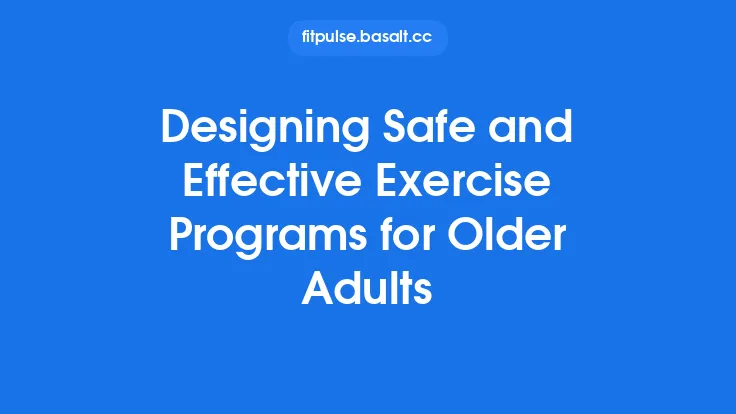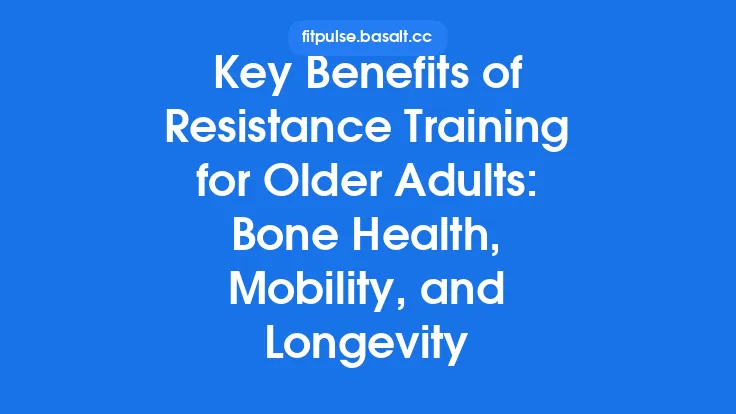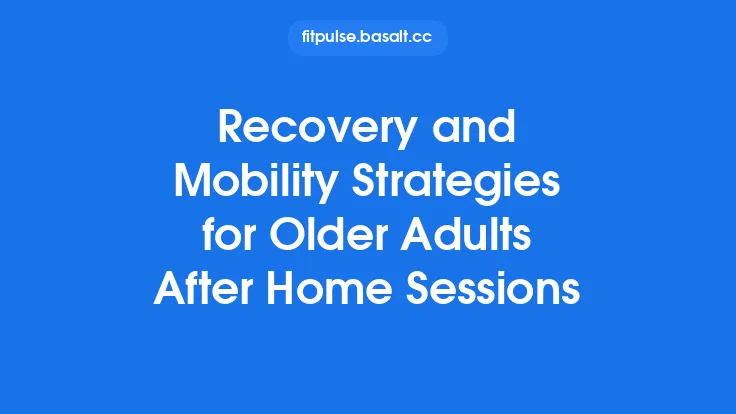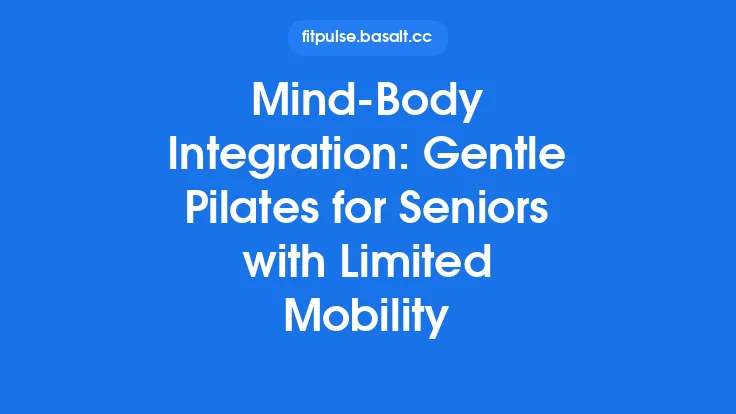Aging gracefully often means finding movement practices that honor the body’s changing capabilities while still offering the physical, mental, and emotional benefits of regular exercise. Yoga, with its emphasis on breath‑coordinated movement, mindful awareness, and adaptable postures, can be an especially powerful tool for older adults who experience mobility restrictions. By thoughtfully selecting poses, using supportive props, and sequencing movements in a way that respects individual limitations, seniors can cultivate strength, flexibility, and a sense of calm without over‑taxing joints or muscles.
Understanding the Unique Needs of Mobility‑Limited Seniors
Older adults with reduced range of motion, joint pain, or balance concerns approach movement differently than younger practitioners. Several physiological factors shape these needs:
- Joint Capsule Stiffness – Collagen cross‑linking and reduced synovial fluid can limit the glide of joint surfaces, especially in the hips, shoulders, and spine.
- Muscle Sarcopenia – Loss of muscle mass diminishes power and endurance, making sustained holds more challenging.
- Proprioceptive Decline – Sensory feedback from muscles and joints becomes less precise, increasing the risk of misalignment.
- Cardiovascular Considerations – A slower heart‑rate recovery may require longer rest periods between more demanding postures.
An adaptive yoga program therefore prioritizes joint safety, controlled muscular engagement, and gradual progression, while also offering the mental benefits of breath awareness and meditation.
Core Principles of Adaptive Yoga for Older Adults
- Alignment Over Depth – Proper skeletal alignment protects vulnerable joints. A slight bend in the knees during standing poses, for example, reduces compressive forces on the femoral head.
- Micro‑Movements – Small, intentional motions (e.g., a few centimeters of spinal flexion) can stimulate joint nutrition without stressing the capsule.
- Prop‑Centric Modifications – Blocks, straps, bolsters, and sturdy chairs become extensions of the body, allowing the practitioner to achieve the intended muscular activation without compromising form.
- Breath‑Movement Synchrony – Coordinating inhalation with opening actions and exhalation with closing actions creates a natural rhythm that supports safe loading and unloading of tissues.
- Individualized Intensity – Rather than counting repetitions, the practitioner gauges effort by the “talk test” (being able to speak comfortably) and the perceived exertion scale (0–10).
Key Modifications and Props for Safe Practice
| Prop | Typical Use | Example Modification |
|---|---|---|
| Yoga Block | Elevates the hand or foot to reduce required flexion | In Modified Triangle, place a block under the hand instead of reaching the floor, decreasing hamstring stretch while still opening the chest. |
| Strap | Extends reach for limbs that cannot comfortably grasp the floor | Loop a strap around the forearm in Seated Forward Fold to gently pull the torso forward without straining the lower back. |
| Bolster or Firm Pillow | Provides support for supine or seated postures | In Supported Bridge, place a bolster under the sacrum to open the chest without active lumbar extension. |
| Sturdy Chair | Offers a stable base for standing or seated variations | Perform Chair Warrior II with the back of the chair supporting the spine, allowing safe hip opening. |
| Wall | Serves as a vertical guide for alignment | Use the wall for Wall‑Supported Half‑Moon, keeping the pelvis grounded while the upper body reaches upward. |
When selecting props, ensure they are non‑slipping, stable, and appropriate for the user’s height and strength. A simple “test of stability” (pressing lightly on the prop while seated) can confirm safety before beginning a sequence.
Designing a Balanced Yoga Sequence
A well‑rounded adaptive yoga session typically follows a four‑phase structure:
- Centering & Breath Awareness (3–5 min)
Seated or supine, guide the practitioner to notice the natural rhythm of the breath, gently lengthening inhalations and exhalations.
Technical note: Slow diaphragmatic breathing stimulates the vagus nerve, promoting parasympathetic activation and reducing heart‑rate variability.
- Warm‑Up Mobilization (5–7 min)
Gentle joint circles, neck rolls, and shoulder shrugs using props as needed.
Focus: Synovial fluid circulation, especially in the cervical and thoracic spine.
- Main Flow – Adaptive Asanas (15–20 min)
A sequence of standing, seated, and supine poses that address major muscle groups while respecting individual limitations.
Key considerations:
- Alternate between flexion and extension to avoid over‑loading a single tissue.
- Include bilateral symmetry (e.g., left‑right variations) to maintain balanced muscular development.
- Use counter‑poses (e.g., gentle twist after forward fold) to neutralize spinal stress.
- Cool‑Down & Relaxation (5–7 min)
Guided Savasana or a supported reclined pose, emphasizing body scanning and breath integration.
Optional: A brief meditation or gratitude practice to reinforce mind‑body connection.
Sample Adaptive Yoga Flow – Gentle Morning Routine
> Duration: ~30 minutes
> Props Needed: Two yoga blocks, a strap, a firm chair, a small bolster
| Step | Pose (Modification) | Duration | Cue Highlights |
|---|---|---|---|
| 1 | Seated Breath Centering (Chair, feet flat) | 3 min | Inhale to lengthen the spine, exhale to soften the shoulders. |
| 2 | Neck & Shoulder Rolls (Seated) | 2 min | Move slowly; avoid excessive rotation if cervical arthritis is present. |
| 3 | Cat‑Cow (Marjaryasana‑Bitilasana) – Chair‑Supported | 4 min | Place hands on thighs; inhale to arch, exhale to round. |
| 4 | Standing Mountain with Block – Block under hand | 2 min | Engage the core, keep knees soft, gaze forward. |
| 5 | Modified Warrior I – Chair for balance | 3 min each side | Front knee bent to a comfortable depth, back leg straight, block under front hand if needed. |
| 6 | Triangle with Block – Block under forearm | 3 min each side | Keep the spine long; use a strap around the back leg if hamstring tightness limits reach. |
| 7 | Seated Forward Fold – Strap around feet | 3 min | Hinge at the hips, maintain a slight bend in the knees, gently pull with the strap. |
| 8 | Supported Bridge – Bolster under sacrum | 2 min | Press feet into the floor, lift hips slightly, rest on the bolster. |
| 9 | Supine Twist with Block – Block under knee | 2 min each side | Keep shoulders grounded, rotate gently from the lower spine. |
| 10 | Legs‑Up‑the‑Wall – Wall support | 3 min | Relieve lower back pressure, promote venous return. |
| 11 | Guided Savasana – Bolster under knees | 5 min | Scan the body, release tension, return to natural breath. |
Progression Tips:
- Increase block height gradually to deepen the stretch.
- Transition from seated to standing variations as confidence grows.
- Add gentle arm extensions with light resistance bands once joint tolerance improves (while ensuring the focus remains on yoga rather than strength training).
Progression Strategies and When to Adjust
- Assess Baseline Mobility – Use simple functional tests (e.g., sit‑to‑stand, fingertip‑to‑floor reach) to set a starting point.
- Incremental Load – Extend the hold time of a pose by 5‑10 seconds every 1–2 weeks, or add a prop that slightly reduces the distance to the floor.
- Introduce New Asanas Sparingly – Limit the addition of unfamiliar poses to one per session, allowing the nervous system to adapt.
- Monitor Recovery – If soreness persists beyond 48 hours, reduce intensity or increase rest days.
- Feedback Loop – Encourage the practitioner to verbalize sensations (“tightness,” “tingling,” “comfort”) and adjust accordingly.
Safety Considerations and Contraindications
- Acute Joint Inflammation – Avoid deep flexion or rotation of the affected joint; opt for neutral spine positions.
- Severe Osteoporosis – Limit forward bends and spinal twists that could place compressive forces on vertebral bodies; prioritize gentle extensions and supported postures.
- Uncontrolled Hypertension – Skip inversions (e.g., head‑stand, shoulder stand) and prolonged breath‑holding; maintain a steady, relaxed breathing pattern.
- Recent Surgery – Follow surgeon’s clearance; use only low‑impact, non‑weight‑bearing movements initially.
- Medication‑Induced Dizziness – Perform balance‑challenging poses near a sturdy surface (chair or wall) and keep transitions slow.
A quick “pre‑session checklist” can help ensure safety:
- Pain Check – Any sharp or worsening pain? Modify or skip the pose.
- Stability Check – Is the prop stable? Test before weight transfer.
- Breath Check – Is breathing smooth? Pause if breath becomes shallow or rapid.
Integrating Mindful Breathing and Relaxation
While the physical component of yoga is essential, the pranayama (breath‑control) and dhyana (meditation) aspects provide lasting benefits for seniors:
- Ujjayi Breath – Slight constriction of the throat creates an audible, steady sound that encourages diaphragmatic breathing and can lower blood pressure.
- Box Breathing (4‑4‑4‑4) – Inhale 4 counts, hold 4, exhale 4, hold 4; useful for calming the nervous system before bedtime.
- Body Scan Meditation – After the final relaxation, guide attention from the toes upward, fostering interoceptive awareness and reducing chronic stress.
These practices can be performed seated or supine, making them accessible even on days when movement is limited.
Creating a Sustainable Home Yoga Practice
- Designate a Consistent Space – A quiet corner with a non‑slippery mat, adequate lighting, and easy access to props reduces barriers to practice.
- Set a Realistic Schedule – Short, daily sessions (10‑15 minutes) are more beneficial than occasional long workouts.
- Use Visual Aids – Print or display simple pose illustrations with cue words to reinforce correct alignment.
- Leverage Technology Wisely – If comfortable, follow a reputable online adaptive yoga class; ensure the instructor emphasizes modifications for seniors.
- Track Progress – Keep a log of pose tolerance, breath quality, and subjective well‑being; this data guides safe progression.
By weaving together thoughtful modifications, prop‑assisted alignment, mindful breathing, and a structured yet flexible routine, older adults with mobility restrictions can experience the full spectrum of yoga’s benefits—enhanced joint health, gentle strength, improved circulation, and a calmer mind—right from the comfort of their own homes.





